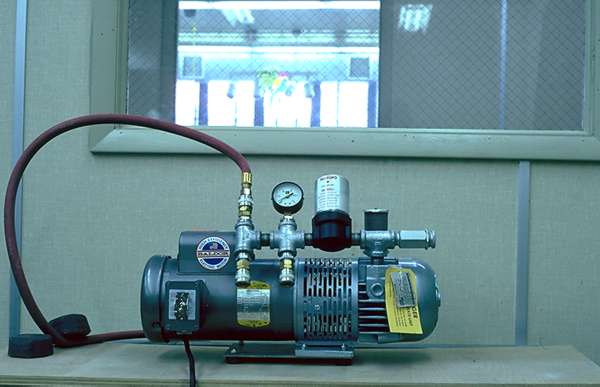Positive Pressure Respirators: A Project Undertaken at the Commonwealth Conservation Center, Harrisburg, PA
by Jane SmithWhen faced with the ominous task of removing cellulose acetate lamination from 3000 17th and 18th century Land Grants from the commonwealth of Pennsylvania, I thought long and hard about the safety issues involved in the treatment of this project. There would be a tremendous amount of solvent exposure. The thought of wearing a standard half-face respirator for hours on end did not have much appeal. Since this project required the use of hundreds of gallons of acetone, I investigated alternative respirator systems. The equipment of choice is relatively simple in construction, easy to use, and saved thousands of dollars when compared with replacing cartridges in respirators.
A huge budget was allocated for organic respirator cartridge changes ($12,000.00 over a three year period). This budget would allow for one change of cartridges per two days of work. All of this seemed reasonable, yet somewhat excessive pricewise! What I chose instead was a Positive Pressure Respirator system. It was a cost effective set-up for this ongoing project and saved almost $7000.00 over the cost of purchasing organic vapor respirator cartridges.
Fig. 1
The Positive Pressure Respirator, or Ambient Air Supply System, uses an ambient air supply at the source of the pump (Fig. 1). When fully constructed, this system funnels fresh air to the conservator working with solvents, delivering breathable air. This is nothing new; paintings and objects conservators have used this set-up on site for many things.
Fig. 2
The chosen set-up was remarkably easy to construct. The ambient air pump (Fig. 1) pulls air from one room of "clean air" delivering it through a hose to the hooded conservator (Fig. 2). The pump has two filters which must be changed every 200 hours or so. Although the pump is not very large (L.: 23"; H.: 15"; W.: 9") it is LOUD. Therefore, the pump must be in a room with clean air, electricity and where it won't disturb others. In my case, I placed the pump in our analytical lab. We strung a 100 foot air supply hose from the pump, across the ceiling and into the paper conservation lab where I worked with the added benefit of a fume extraction hood. The hose clips to a canvas belt worn by the conservator and connects the Breathing tube and Tyvek hood assembly. When the pump is turned on, it creates a positive pressure which pushes "clean air" into the Tyvek hood which surrounds the head of the conservator wearing the hood. the hood is not sealed at the neck; it is merely this positive pressure that keeps the solvents from the conservator.
The Pros of this system are:
- It gives greater protection for higher percentages of solvent exposure.
- Avoids respirator fatigue
- More comfort than 1/2 face respirator
- Shields eyes
- Ease of speech
- No need for respirator fitting
- The system can accommodate up to three people by attaching three hoses to the pump
- In some cases, it is less expensive than constantly changing filtering cartridges on a mask
- There is no toxic waste of used cartridges
The Cons of this system are:
- Limited visibility below and to the sides
- Limited mobility based on hose length
- Needs area for loud pump with plug
Supplier: Fisher Scientific for
Distributors: 3M and Allegro
Cost of total system in 1995: about $2000
Conservation Center
Los Angeles County of Art
Publication History
Received: Fall 1997
Paper delivered at the Book and Paper specialty group session, AIC 25th Annual Meeting, June, 1997, San Diego, California.
Papers for the specialty group session are selected by committee, based on abstracts and there has been no further peer review. Papers are received by the compiler in the Fall following the meeting and the author is welcome to make revisions, minor or major.

